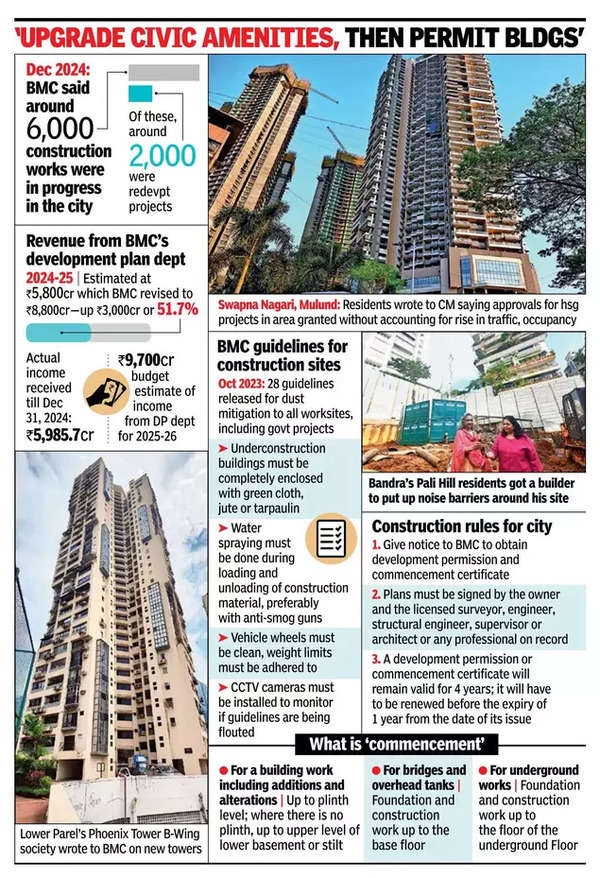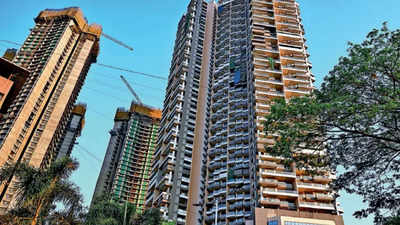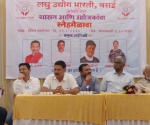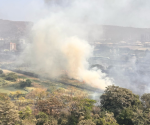Mumbai’s vertical housing boom: Can infrastructure keep up? | Mumbai News – The Times of India

MUMBAI: Earlier this month, residents of Lower Parel’s Phoenix Tower B-Wing Co-operative Housing Society Ltd wrote to the BMC to halt granting of permissions for new towers in the locality until existing infrastructure is upgraded.
This isn’t just a Lower Parel issue-it’s happening across the city.
From Ghatkopar to Bandra West, Andheri’s Four Bungalows to Mulund, the skyline is transforming rapidly.What were once 6-7-storey buildings are now soaring to 18-20 floors and beyond, and open plots along arterial roads such as L B S Marg in Mulund, Kanjurmarg and Powai are turning into dense gated complexes.

Yet, outside these gleaming new towers, roads remain of the same width, and water and sewerage lines haven’t expanded to match the swelling population-leaving urban planners and experts questioning how the city will cope.
Milind Kulkarni, a PhD in environmental engineering from IIT Bombay and a resident of Four Bungalows in Andheri, an area experiencing rapid vertical growth, pointed at the challenges residents face.
“We are grappling with dust, noise and the constant movement of dumpers, adding to the chaos of an already congested city,” he said. “Many new buildings rely on tanker waters because the BMC cannot supply it. But how safe is this water? And why grant construction permits if basic civic amenities cannot be provided? Redevelopment has now become a lucrative option, often driven by the promise of larger living spaces.”
In western suburbs, Borivali’s I C Colony is also witnessing a surge in redevelopment, with several residents complaining that taller buildings are blocking natural light. “No one can stop redevelopment if all permissions are in place, but it has led to an influx of new residents-most with their own vehicles-making it increasingly difficult to commute on the same old roads,” said an I C Colony resident.
In Mulund West, residents of Swapna Nagari wrote to the chief minister on Feb 7 on a large-scale housing and commercial project coming up in their locality. In the letter, some of the key concerns listed out were that the project’s approvals such as the commencement certificate were granted without accounting for the massive increase in vehicular movement due to construction activities and future occupancy. “The only access road (13.4m wide) between Swapna Sagar and Swapna Sangeet societies is already struggling to support daily traffic. This is also the sole approach for thousands of residents in Yogi Hills. Veena Nagar bridge over Tansa pipeline is not designed for heavy vehicles, making the existing situation even more precarious,” stated the letter.
Prakash Padikkal, president of HIRWA (Hillside Residents Welfare Association), said while they have no opposition to development, the lack of proper planning and transparency will create long-term hardships for residents and commuters alike. “I have lived in Mulund for over three decades and have seen the skyline change and wonder how the roads and other infrastructure will cope with it,” he said.
Bharat Soni, secretary of the association, pointed out that Mulund was a much better planned suburb when compared to others and the burden it is bearing now is probably the reason the area witnesses water-logging, bottlenecks and traffic congestion which wasn’t the case earlier.
Coming to Bandra West, in Pali Hill’s Dilip Kumar Lane, 12 buildings are being redeveloped. Madhu Poplai, secretary of the Pali Hill Residents Association (PHRA), said most buildings were originally 6-7-storey high but are now rising to 20 storeys after redevelopment. “For older buildings, there’s no debate about the need for redevelopment. The real question is whether the existing infrastructure can support this vertical growth,” she said. “Authorities must plan ahead, ensuring that pipelines for water, sewage, and stormwater drainage are designed to meet future demands.”
Poplai added PHRA has its own charter for developers, outlining guidelines to maintain discipline during construction. The association also circulated a notice to all redevelopment projects in Pali Hill, specifying rules on work timings, adequate fencing, noise and light control, and restrictions on heavy vehicles.
Ghatkopar, in the eastern suburbs, is witnessing a similar trend, with old mid-rise homes making way for skyscrapers. Former BMC corporator Pravin Chheda, though, emphasised the need to view Ghatkopar’s redevelopment from 2 perspectives. “The first is the redevelopment of Mhada colonies in Pant Nagar, where vertical growth will bring in more cars, increasing the burden on an 18-meter-wide road,” he said. “The second involves private buildings rising from an average of 3-4 floors to over 15 floors.The narrow lanes will pose challenges, especially for traffic flow and emergency services like the fire brigade.”
A BMC official said developers have to pay BMC development charges for the civic body to make available the commensurate infrastructure. Planners say this is not happening on the ground. Vivek Pai, architect and urban planner, said, “The problem is one department is not talking to another and so while a builder gets permissions from building proposal department, water, sewer and solid waste departments are not in tune with a 4-storey building going much higher. This however has become a problem in the last decade when FSI shot up leading to many constructions spiralling.”
















